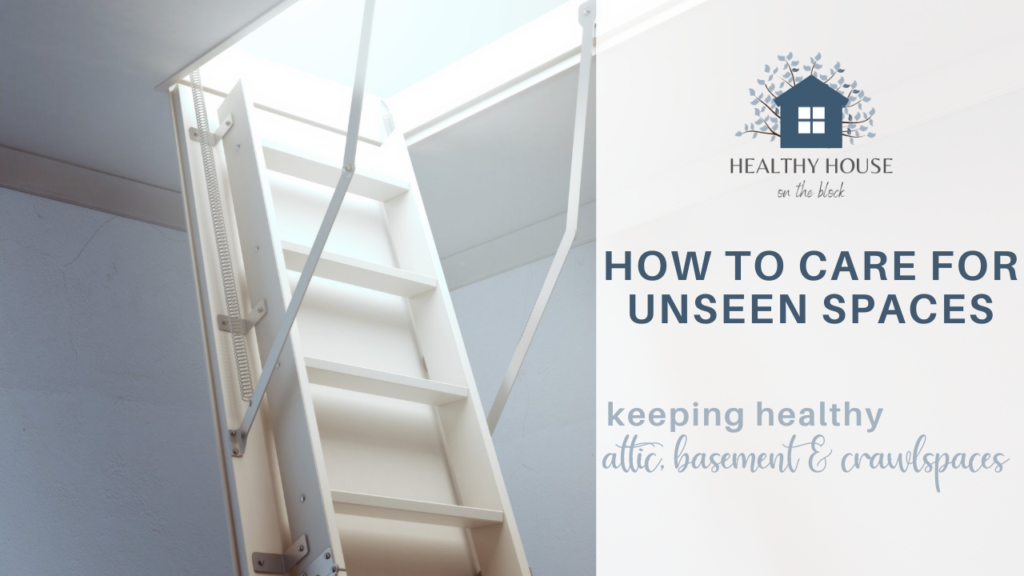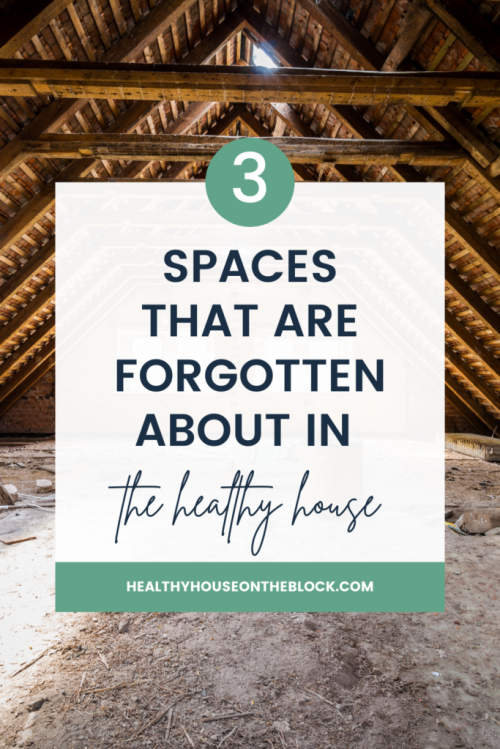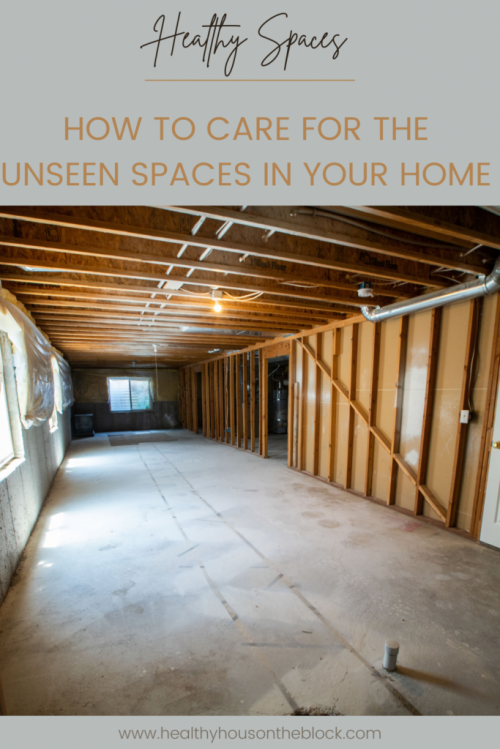
Are there parts of your home you haven’t seen in years? It’s actually quite a common thing, especially if you don’t have a great way to access some of these spaces. But one thing I’ve learned as both a home inspector and as a homeowner myself is that there is important home maintenance that must be done with attics, basements and other unseen spaces in your home.
And when you miss out on even taking a peek into these spots, you may miss some big red flags and warning signs that something is going on with your home, making it unhealthy. One of my biggest pieces of advice is to at least LOOK in places you don’t visit on a regular basis. Just a peek with a flashlight if you can. It could mean the difference between finding a potential problem and finding a full blown disaster.
One of the biggest things we have to watch for in these unseen spaces is moisture and potential moisture intrusion. Keeping water out of your home wherever you can is the biggest way to prevent big problems. Home maintenance will often be about preventing moisture in these unseen spaces.
Another quick tip before we dive into each of the unseen spaces in your home is all about storage. Make sure you’re not just using these spaces to fill them to the brim with the things that need to be stored. While many of these spaces can hold some storage, they’re actually functional spots in your home and need to be somewhat open for home maintenance and air flow.
Let’s take a look at the attic, basement, crawl space, and utility room and focus on some simple home maintenance to-dos in each space.
ATTIC
Most homes have SOME sort of attic space that you can access. However, some homes may have a finished attic, and therefore you wouldn’t be able to access any sort of open space that we typically refer to as an attic. Your attic may have stairs up to it, an access hatch or an access hatch with a ladder attached (think National Lampoon’s Christmas Vacation if you will).
The attic is probably the place in our home we skip out on visiting the most, unless there’s something bringing you up to take a peek around. Often it’s dark, with no lightning and with no great way to access the space, so it’s understandable why we avoid this area or forget about it entirely.
But the good news is, usually the attic has the least amount of maintenance that needs to be done to the space in comparison to other areas around the house. The attic acts as a buffer between your living spaces and the outdoors. It often contains insulation, which helps create a powerful thermal barrier between your home and the exterior elements.
Popping your head into the attic every 6 months to a year is a great idea. Truly, all you should need to do is grab a ladder (if you need to) and a flashlight and stick your inside the attic space. If you’re squeamish, you can even just hold your camera on your phone above your head with your flashlight on and take a video to view when your safely back on the ground.
When you’re in the attic space, I recommend you wear a mask covering your nose and mouth to prevent you from breathing in either potential asbestos from insulation or fiberglass fibers from insulation. And if you don’t want to shake out your hair, wear a hat to protect from insulation that will fall down. I’ve gotten in the habit of putting down a dropcloth on the floor that will catch insulation that falls down so I don’t have to vacuum.
And what do you look for?

Moisture: Like I said the biggest home maintenance items I’ll share are about preventing moisture. The attic is no exception. Moisture can show up on your attic sheathing (the boards on the inside of your roof) and can be from either condensation or a roof leak. A moisture spot can be old or new, but it will always leave a stain, so verify that the moisture is in fact current and not an old stain before you start finding solutions.
Most moisture spots are around chimneys and venting that terminate through the roof. A home maintenance item may be to seal around these terminations where they meet your roof to ensure no moisture can seep through.
If the problem is a big one, or you notice it worsening over time, it’s time to call in a professional company to assess your roof and repair any parts that may be affected by moisture.
Evidence of Animals/Rodents/Insects: This is probably the BIGGEST reason most of us avoid the attic. No one wants to come face to face with anything that’s made it’s home inside your attic. BUT, this is more rare than you think. If your eaves around your house are sealed properly without big gaps or rotting wood, rodents, animals and insects won’t be able to get into your attic space.
Simply check around for evidence of burrowing in the insulation, which can indicate rodents. You’ll also want to check and make sure you don’t see wasps nests, or other insect homes around the corners or the peak.
If you see any droppings from animals or insects, you’ll want to do some maintenance to the exterior to seal up your space and then some maintenance to the inside of your space to get rid of the visitor. You can either DIY this or call in a professional.

Daylight Showing: When you look into your dark attic, are you seeing daylight peeking through around vents and at joint connections? If you see more light coming through than just the main part of a passive vent, you may want to have that area sealed up.
A spot where daylight can poke through without a screen means that insects, animals or moisture can come through where it’s not supposed to. I often see these spots around the vents on the side of the attic, called gable vents and around chimney terminations into the roof.
You could easily take care of this maintenance yourself or with a handy man by sealing these spots with an exterior caulking and then continue to monitor them.
Insulation & Venting: If you notice that the insulation has settled or has large bare spots around your attic, it might be time to add some more. Or, if you can feel a draft coming from your attic access door, it might be time to add insulation around that spot.
Either way, an adequate amount of insulation is necessary and should be included in home maintenance to keep a proper thermal barrier intact around in the attic space.
You’ll also want to make sure that all the vents are unblocked and intact. Vents are often within the eaves of our homes, and so you may see a plastic baffle (or chute) that keeps the vent open and free from insulation along the sides of your attic. Make sure these haven’t fallen down, and if they have, make sure your vent isn’t blocked by insulation.
Adequate ventilation in your attic space is a huge part of maintaining a healthy house.

BASEMENT & CRAWL SPACE
Some home’s may not even have a basement, depending on where you live in the country. I live in Minnesota where basements are in pretty much every home. If you don’t have a basement, you likely have some sort of crawl space where plumbing can run for your home.
Your basement could be completely finished or be unfinished and used as a storage an utility area, but either way, even if you have a small corner of your basement that’s left unfinished or left for storage, it’s a good idea to have a look around now and then.
Here’s what to watch for:
Moisture: Again, home maintenance can sometimes revolve around moisture and moisture prevention. In the basement moisture can mean condensation on the concrete or stone walls, or it could mean moisture entering through cracks and spots where water from outside your home makes it inside.
Condensation on your walls in the basement can usually be fixed with some waterproof barrier paint that you can get at a hardware store. You can do this on both the exterior and interior of your foundation walls and it will help prevent moisture in the future.
If you’ve noticed water coming in cracks or at seams between floors and walls, you’ll need to seal those up with a caulking first and then add the waterproof barrier.
Before you do your home maintenance here, try to find low VOC picks for both caulking and for a paint on waterproof barrier:

Musty Odors: You know that smell — it’s just kind of a basement smell. It’s a little musty and it’s an indication that there’s high humidity levels in your space. One thing we know about both home maintenance and maintaining a healthy space is that we want lower humidity levels inside. High humidity levels often invite mold and mildew to enter our space as well as insects. But high humidity levels can also encourage materials with VOCS to off gas at a much higher rate than when they’re in a dry climate.
You can try to hunt for moisture entering your space and take care of the problem by sealing or waterproofing the walls. You can also add a dehumidifier to your basement to pull moisture out of the air on a regular basis, as the basement can just be a damp place in the home.
You may also want to consider removing carpet from the floor, and replacing it with a hard surface flooring. This will help moisture from being continuously absorbed and sticking around.
New Foundation Cracks: If you have exposed foundation walls in your basement or crawl space, you’ll want to keep an eye on any cracking that may appear. Regular home maintenance is to fill in any cracks that appear over time. It’s completely normal to have hairline cracks here and there that do not worsen.
If you notice a crack worsening, or a new one that is larger than a hairline crack, it may be time to call in a professional to assess your home.
The best way to prevent cracking from happening to your foundation walls it to keep moisture away on the outside of your home. Some quick home maintenance points to prevent his are:
- Make sure gutters are clean and draining at least 6 feet away from your foundation
- Make sure grading around your home is sloped away from your home to allow proper drainage (positive grading)
- Make sure vegetation is not growing directly next to the foundation walls outside and ensure there’s a buffer space between plants and vegetation
Outside home maintenance can prevent A LOT of problems from happening on the inside of your home and it can keep you from experiencing some BIG problems in the future.
Flooring: Most basements have a concrete floor either exposed or underneath a layer of flooring. If you have a crawl space you may even have a dirt floor. Dirt floors should be covered with a barrier layer, like a plastic sheet to prevent moisture and gasses from entering the home naturally through dirt.
If you have an exposed concrete floor you’ll want to check for that same cracking that I mentioned with the foundation walls. You can also check for a generally damp feeling on the concrete, which can indicate moisture entering your space this way.
If you have carpet, pull up the corners every now and then and check to see if any home maintenance is in order to take care of moisture intrusion around the edges. I always think it’s best to keep carpet out of the basement as it can be a naturally damp space, but if you have it, just continue to check the flooring for moisture.

UTILITY ROOM
Some of us are lucky enough to have a whole space just devoted to utilities. Or you may have a corner of your basement or perhaps the space under your stairs. If you live in a warmer part of the country, you may even have your utilities in the garage or in an outside closet.
Typically if there is a room devoted to utilities, you won’t be visiting it very often unless you have some home maintenance to do. These rooms can get forgotten about and unfortunately they can have problems arise without us even noticing it.
If you can leave the door to your utility room open as a reminder to check in every now and then, that can be a great reminder. Or, you can set a calendar reminder to replace filters and check on your space.
Here are some of the big places you want to watch in your utility room in regards to home maintenance:
Venting: Venting from appliances that use natural gas (like furnaces and water heaters) should be completely sealed with no holes or worn areas. If you notice a hole or an area that is either worn, or any place that combustion gas can escape, you’ll want to call someone to repair it right away.
The gas that is expelled from the heating process in these home appliances is called combustion gas, and should be carried directly out of your home. Some newer appliances have PVC piping for this rather than metal venting. When gas is allowed to seep back into our space, we can be exposed to carbon monoxide, which is extremely dangerous and can be deadly.
Furnace/Boiler: If you have a furnace, a great excuse to head to your utility room is to change your furnace filter.
Other than that, there isn’t too much to check in on, except to make sure that the appliances are working and that there are no leaks from condensate lines or piping. Just a quick visual check of these two should suffice.
I would also recommend getting a “tune up” every two years to ensure that the appliances are in fact working well and there are no problems going unnoticed. Better to be preventative here than to wait until there’s a problem.

Main Water Valve: Do you know where your main water valve is? So many times it’s hidden in a closet somewhere or in a place that doesn’t get checked very often. Make sure you know where your valve is and then keep an eye on it every few months to make sure no leaks are present. At the first sight of any sort of drip or leak from the valve, you’ll want to make a call to get it repaired.
Essentially the valve will never magically start getting better, and you don’t want to wait until you have a bigger problem on your hands and you have to turn off the water to your whole house at an inconvenient time to do the repair.
Water Heater: Some people drain their water heater once a year, and others just leave them. Personally, I think it depends on your water quality, and so for our family, we just let ours work without bothering it. If you have extremely hard water with no water conditioner system, you may want to look into this option.
Otherwise, generally, you just want to keep an eye on the venting for your water heater and to make sure there’s no discharge from any of the drains or valves. The venting should be completely intact with no holes, disconnections or worn areas, just like the furnace.
And finally, if you see water coming from your water heater underneath, it’s time to start shopping for a new one and getting it replaced. Don’t wait until this becomes a big headache. It’s much better to deal with it right away when there’s a small leak.
Creating a healthy house includes the bones and systems within the home too, which can sometimes be forgotten. By keeping up on home maintenance and just visually looking at some of the big unseen spaces in your home, you can protect your space and protect your family.




